#Indian Myth and Legend
Explore tagged Tumblr posts
Text




Warwick Goble - “Indian Myth and Legend” by Donald Alexander Mackenzie, 1913.
22 notes
·
View notes
Text
In Which I Ramble About Pavitr's Character Design and the Indian Cultural Stuff Related to It
DISCLAIMER: I'm an Indian, and these are all my thoughts and analyses, but I'm also just one person and by no means am I speaking for everyone. I am not all knowing, and I am not immune to being wrong sometimes. These points are all my own thoughts and stuff that I know through my lived cultural experiences and some history and book knowledge, but I've not particularly researched any of these. I'm just out here giving my take from what I know. This is mostly just going to be me rambling, okay? Okay. Let's go!
Anyway okay so I just wanna go from the top down:
No. 1:
First of all his hair
His fucking hair
This is one aspect that i k n o w I'm overthinking and probably wasn't as significantly thought out in the design but it just Spoke to me and by all accounts I'm not the only one
But I'm so glad we have him with his thick gorgeous fricking hair, especially them being like curly/wavy and slightly long instead of straight and cropped or whatever
Like. Indians usually have very thick and luscious hair, not everyone ofc but generally it's a thing, and it's considered a point of pride to have long dark thick hair.
And the thing is for the longest time the beauty standard in India was to have very straight and shiny hair, all the actresses and heroes were doing it, even though that's literally not the realistic case for a lot lot LOT of Indians. There's a pretty big variety of hair texture in India; some of it is regionally concentrated too, eg. in South India you get a lot of frizzy, tightly coiled hair that's rough textured, whereas curly hair is usually silkier and looser curled as you go Northwards,, Bengalis tend to have very wavy thick hair,, etc. By no means a rule or anything, it's just a thing that there's a lot of curl variety and a lot of it was for the longest time considered ugly and unkempt (there are some classist/regionalist elements to this stereotype also unsurprisingly) still is by some people,,, bc the standard was Shiny Straight Hair. It's a standard that's slowly shifting. It's currently leaning more on the wavy and voluminous side. But it's def a thing still.
All that to say, it makes me so so happy to see Pav with his curly-ish lush hair that he wears with such pride and style,, that are a symbol of his own pride and self care too!!!
Also the line about "coconut oil, prayers and good genetics" - I LOVE THAT REFERENCE AHAHABSSK, using coconut oil for the hair is a very common thing here, it's so so good for the hair and the scalp alike and it's relaxing to massage it in too.
I've seen people try to write Pavitr in fics as "quickly brushing some coconut oil through his hair" as part of his morning routine and. Um. That's not how it's done askaskjas, I don't mean to be rude to the writers at all, everyone does the best with what they know and no one knows everything, but also practically speaking that would be greasy and awful.
There are multiple ways to apply coconut oil, ofc. Coconut oil is often massaged into the scalp and rubbed into the hair like an hour before washing, sometimes with lemon juice mixed in, and then washed off when bathing. Some people, especially those with drier and finer hair, apply it as a regular after-hair-wash thing, too, but even so it needs to be rubbed in.
A really beloved thing we have is coconut oil champis, too! This is basically when you sit down cross legged in front of youe mother/grandmother, and she massages the coconut oil into your scalp and hair in a way that literally cures all tension and headaches and leaves your head reeling and is so so good for hair and stress and everything. It's a family bonding thing more than just a hair routine. It's not always done by the mom/grandmother ofc, it's just how most of us first experience it, and they have a technique that none of us can ever quite replicate to the same effect later. As we grow up, we often do it for ourselves and for others. It's a weekly or monthly or even just occasional thing depending on who you ask. But yeah that reference was great I love it dearly!

Also about the hair length
So in the current modern "civilized" standard (Indian schools and society in general tend to do a lot of shit trying to assimilate us into western culture and stamp out our own,, for example all my life I've been in schools where speaking Hindi and Telugu and stuff in class or in the hallways was Wrong and Forbidden and We Must Speak Only In English Bc We Are Educated And Cultured. This is so fucking hypocritical bc they would also have Hindi and Telugu classes and then criticize us for not getting it right or whatever), boys are meant to have short hair. Teachers literally single boys out in class for leaving their hair longer, not the exact length they set as the limit. This was my entire school experience; thankfully it doesn't seem to be the case in college, but that may just be bc I'm in an artsy college. In the workplace it's less stringent but it's still a thing.
HOWEVER, historically and culturally, long hair was considered good and even Important for both men and women. There's huge regional variations in this ofc; Maratha peshwas and higher classes and stuff for example wore a "pilaka" (idk what else it's called), which is the head shaven clean except a tuft in the middle that's sometimes braided. Brahmins still do it too.
But my point being, long hair was considered good for the most part, at most it would be worn in a bun for fighting and working,,, braids are a pretty big deal too. Having to cut your hair short=a symbol of dishonour and/or exile, or reserved for menial workers and so called "low classes".
(This is not stuff you even get explicitly told btw. This is stuff I've mostly inferred and studied from history and mythology and stuff , so there's no guarantee I'm 100% right)
Also, in Sikkhism (I'm not Sikh myself so correct me if I'm wrong, this is just what I know) having long hair is super fucking important for men. The hair is wrapped up in the turban, and the turban is a symbol of honour and pride and literally considered life. The long hair is considered sacred.
Removing the turban is basically a symbol of literally losing your honour pride and sense of self,, not just in Sikkhism, just generally at this point. Cutting your hair? Insult on injury.
Pavitr doesn't have particularly long hair ofc
But having grown up with such rigidly enforced things abt boys having very short cropped hair, it makes me so happy to see an Indian character who defies that.
Also!! Quick tangent about braids and their significance,, they're considered very beautiful and another symbol of pride, intricate buns and what not too! Just wanna drop this to give you an idea of what i mean:
In the Hindu myth of the Mahabharata, Draupadi, the wife of the Pandavas (she's a very interesting and important and beloved character, regionally also considered a goddess, she was a princess born of fire married to five princes and the vengeance for her honour literally fuelled the war for righteousness etc etc) vows never to braid her hair again until she has washed it in the blood of Dushasana, a man who forcefully tried to disrobe her in court (it's a whole myth of its own). At the apex of the war, Bheem, her husband, brings her his blood. She washes her hair in it and then for the first time in thirteen years, she braids it.
Braids are not as significant now but it was basically a Pretty Big Deal and I just wanted to talk abt it.
In Hinduism too the gods are portrayed with long hair, it's a Thing.
No. 2:
Okay so moving more downwards,, I have a bunch of Thoughts abt Pavs mask design!

Okay so obv we have the spiderweb-pattern that's a given.
But. The interesting parts are these:
The bindi-like design on his forehead.
Bc my point is
Sure that looks like a bindi. And that's beautiful in itself but I HAVE ANOTHER TAKE
Bindis are traditionally worn by women as a symbol of beauty, prosperity, and again, pride. But while nice, that's not quite a symbolism that fits imo
You know what else is ver similar where my mind immediately goes? A tilak.
The shape is kind of off for a tilak actually, a tilak is more of a U or a V with a dot or a flame-like stroke in the middle. So in that case it looks more like a bindi
But i really like thinking that it's inspired by a tilak too, bc
While a bindi is a decorative mark stuck or painted on a woman's forehead as a symbol of beauty and prosperity
A tilak is basically a mark that's finger-painted on the forehead of , usually a man but there's a softer smaller version for women too and ofc there are women warriors who got tilaks, for auspicious and blessing reasons. So in a Puja or ceremony, a tilak is put as a blessing and an auspicious thing, also meant to impart strength. The head of the household usually gets the most striking or biggest one.
Pandits usually wear tilaks for blessing purposes too, although their design is different and more elaborate than the ones given to others
Gods and goddesses had their own tilaks, some of them very distinctive like Shiva's
The part that applies to Pav is the warrior tilak
Basically before a king or warrior went to battle, it was customary to do a small sending off ritual and for the wife or mother to put the tilak for them and say "Vijay bhava" (may you be victorious)
It's still done for big undertakings and challenges like exams and new jobs and stuff.
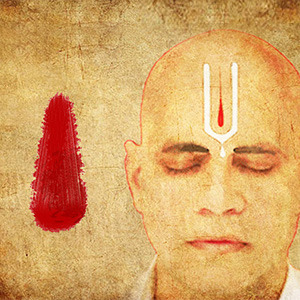
It's basically for strength, bravery and victory
The main difference in a bindi and tilak is the intent:
Bindi is for beauty
Tilak is for valour
Which. For a HERO. Just. Chef's kiss.
2. the markings around his eyes!!
I'm sure this has been said before, but it's very very reminiscent of kathakali makeup.
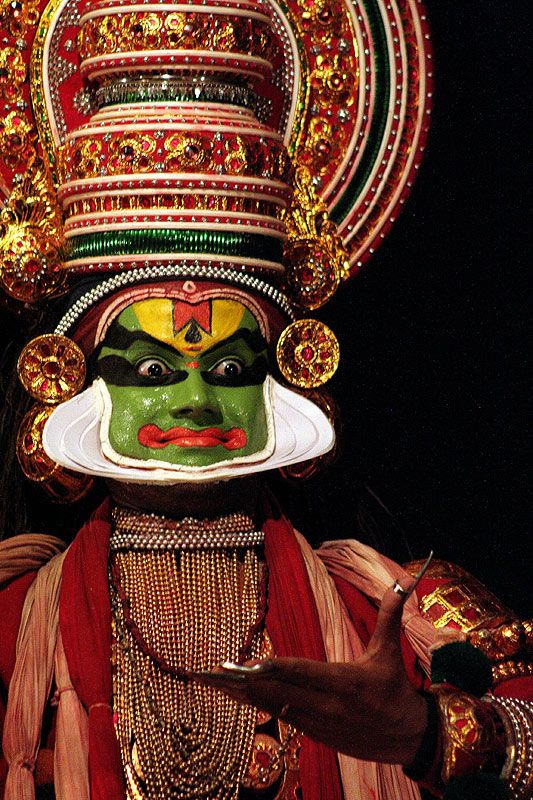
Regionally there's a lot of eye makeup stuff also btw. There are some absolutely beautiful tribal designs and regional designs with a lot of colours but I cant remember specifics rn
Also!! The very distinctive black lines around Pav's eyes?? I love them sm bc they feel so so based in kohl and kajal. Another huge beauty and often pride related thing.
There's even a whole thing where a mother or older sister will often rub a bit of her kohl off on her fingertip and press it behind their loved one's ear so that "buri nazar na lage" (no one's bad gaze catches you). It's called a kaala teeka
The idea being that you're so beautiful and/or cute and bright and lovable and nothing should jinx that and nothing bad should happen to you. It's very rare now and I've never experienced it myself but it's so so precious <33
3. the white markings on his cheeks!
I've seen that explanation of how it's reminiscent of Ganesha, the elephant headed god who is kind of a symbol of new beginnings, intelligence, prosperity, and a ton of stuff I don't even know how to explain honestly, but he's very cool and beloved and has a lot of Good Vibes™ and i love him basically.
I personally am reminded more of kathakali makeup again!! But that explanation is very cool too and i like it!! I don't know if I agree bc i think it m i g h t be a blasphemy to have that imagery on your face, afaik no one here does it for any reasons and we have literal festivals and pujas dedicated to Ganesha
But then again I am a human with limited knowledge and i don't know everything
I personally think the tusk like designs are very cool. However, I also think it would be a bit of a No No for religious reasons. I also think it reminds me more of classical dance face makeup and stuff.
I also think if they meant to make it a Ganesha reference, then he should only have a tusk on one side, bc there's a huge deal about Ganesha being "ekdanta" (transl: one toothed) bc he has a well known myth of breaking off one of his tusks to write a mythologically and culturally significant epic.
There are also a lot of actual cultural face painting things in India that are way cooler than the Ganesha thing in my opinion. So while that theory is cool, I don't personally agree with it. I could be wrong, again, idk what the design intent was exactly.
No. 3:
Next thing: this is a very very small thing and i only have a sentence on it, but i really appreciate Pav's neckline in his suit.
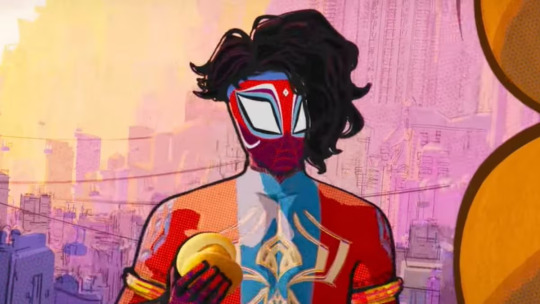
The neckline here? That's the kind of cut that's most typical of kurtas. Especially more ceremonial, kingly, wedding sherwani, or generally festive attire; a regular kurti might have a v-neck or something, but this curved collar? Very Indian and classy in a way I can't fully explain.
No. 4:
This next thing I'm going to go completely ballistic about, everyone hold on to your seats!!!
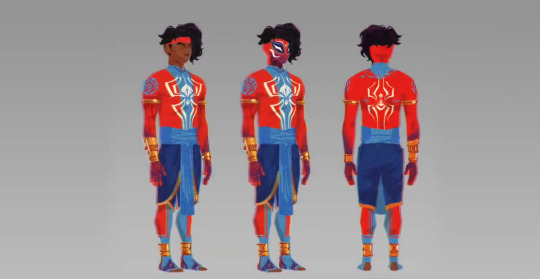
THE FUCKING MOTIF ON HIS UPPER ARMS. IT'S EVEN ON THE MEHENDI-ISH PATTERN ON HIS WRISTS AND HANDS. THE SPIDER SHAPE TOO. I AM NOT NORMAL OKAY
LISTEN.
LISTEN TO ME
TBIS IS CONFIRMATION THAT KRISHNA PAVITR IS CANON
HE IS SO SO KRISHNA CODED
Idc if I'm delusional, i DARE you to look at that blue design and tell me it doesn't look like a peacock feather
THE SHAPE OF HIS FUCKING SPIDER IS OH SO SUBTLY CURVED TO BE PEACOCK FEATHER SHAPED TOO
There is no human way for me to be normal about this i need a minute
Okay for context:
Krishna is a very important and beloved god in Hinduism. I cannot overstate the love I have for him, even being mostly non religious myself.
There is SO MUCH about him he is such a big deal and thanks to him being made a character in popular Indian cartoons and so many animated and live action movies being made about him, he is literally woven in the fabric of our collective consciousness and love for our culture
He's a mischevious and fun and chaotic and lowkey antiestablishment kid deity. He contains the literal universe. He has a deep abiding love for his people and his family and loved ones and the world he serves. He is a dancer, flute player, sweetheart, lover of life. He has a thousand wives, yet one Radha who he never married but is his literal immortalized soulmate. He guides heroes to duty. He is full of wisdom but also silly hijinks. He is so so beloved.
The peacock feather is his symbol! You could see the peacock feather anywhere and it's immediately OH KRISHNA! He wears a peacock feather, famously. In all his iterations, from childhood to adulthood. Peacock feather is his emblem.
Krishna is depicted through the peacock feather. It's become a very common motif in arts like mehendi and various textile arts to have peacock feather and peacock patterns; I'm sure that existed before Krishna too in several cultural circles but he is definitely a huge part of it since. There is a chikankari motif that is very recognisable that's reminiscent of peacock feather but I'm mostly unsourced on that, going off my own interpretation
But there's a definite link between peacock feather=Krishna=inextricable part of culture and art.
At least in North India. He's less of a big deal the further south you go. Still very widespread and overall loved tho.
So anyway seeing that peacock feather type motif on Pav?? Mixed with his Spiderman identity??? Is so amazing to me.
Krishna coded Pavitr real ✨
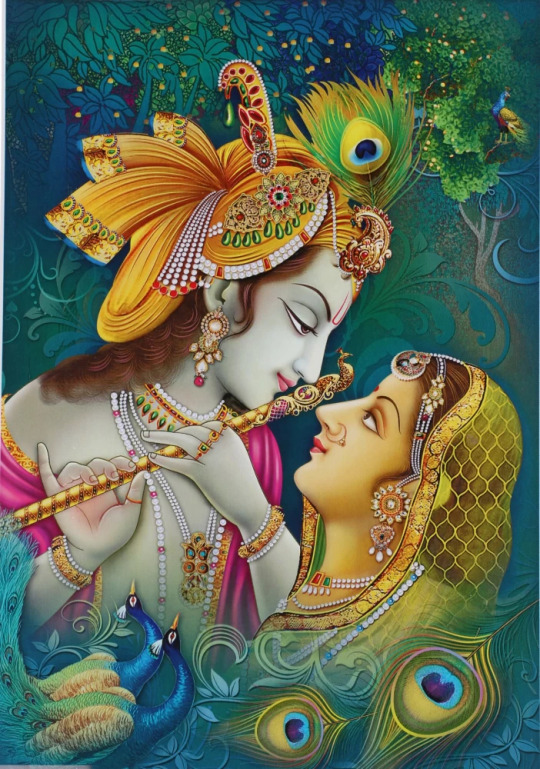
(Also yeah people have already pointed out that Pav's hand designs are based on mehendi so I don't need to go into that askjasjkas)
No. 5:
Also. Huge fan of his arm cuffs. It's just another Indian warrior thing; often in ye olde times and in mythology, the cuff would be a lot simpler, often just a thread with an amulet to grant you protection. But it steadily became fancier, and now it can be decorative or a valour thing or both
Very often just decorative now actually. Often seen in weddings and ceremonies too
No. 6:
Okay about his bangles now:
I absolutely LOVE THEM I love them so much I am so obsessed with them actually!!
So. First of all
I remember there being a confusion in like earlier fics especially on whether they were bracelets or damrus or bangles or what
And i have Thoughts
So first of all
They are not damrus/damarus.
Damarus are a musical instrument made of wood and with two beaded ropes to beat on the small drum-like ends. They're also symbols of lord Shiva who uses a damaru.
They are very different from what Pav wears and i remember my fucking whiplash when earlier fics called his bangles damarus. I think i choked on my maggi.
I don't mean to be rude to the writers ofc, they were doing the best with what they knew. But it's just very jarring to me to hear that
I think an explanation I heard was that Pav's web shooter design was inspired by damarus? Which yeah I get that and I actually wanna talk about it bc I very much see it. But they are very much NOT damarus themselves
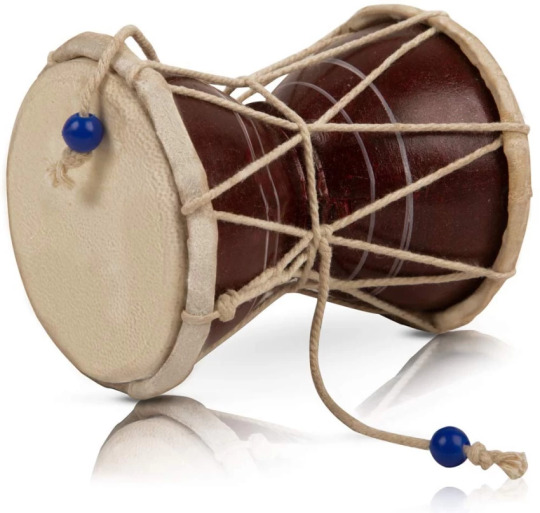
So
First of all i personally have never seen nor heard of the kind of bangles Pav wears which appear to have a strip of cloth in the middle? While being gold cuffs on both ends? Which is new and interesting actually and opens up aspects abt his character that i find really interesting
Bc first of all: that implies he made them himself from stuff he already had inspired by things he saw. It seems, at least to me, like he used bangles/kadas he had to make the shooters he uses, which are designed the way they are for easier slinging and his cool tricks with them which would be harder if they were solid gold, and also the shape when he does the cool yoyo-y trick and hits The Spot with it and everything is very damaru shape. Which is also pretty cool if it's meant as a reference to Shiva and his damaru (he's a very fierce god with the damaru) or a reference to the street performers who use it nowadays.
Either way - and also additionally the fact that PAV LITERALLY DOUBLED HIS BANGLES AS WEB SHOOTERS WHICH IS SO CREATIVE AND SMART - and developed his own whole signature skillset with it?? And made his own bangle/shooters as I said before????
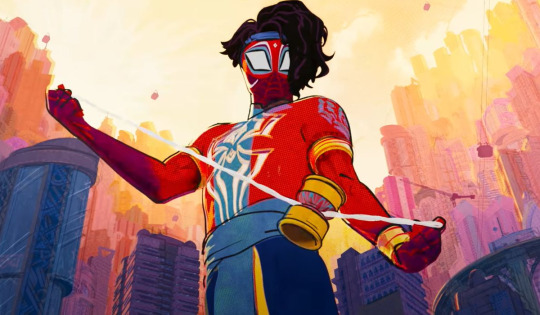
My boy is PEAK jugaadu
He is the embodiment of jugaad
Never has anything been so true to the Indian spirit than jugaad
Okay so for context, the jugaad that I keep talking about:
It basically means makeshifting and/or inventing stuff you need from the limited stuff you have. That's a very simple way of explaining it. Just imagine that, but up the silliness level x100.
For example, a guy jugaaded a showerhead by poking holes in a sprite bottle and putting a hose in it and routing it to the tap.
Jugaad can be both very smart, and very funny and silly
And it usually involves combining useless stuff/trash/just stuff you had lying around to make smth that you didn't wanna waste money buying, and often ends up having more functions than the stuff it was meant to replace. This but it's also very crackheaded. Like idk how to explain. It's basically makeshifting, but it's just developed into such an Indian Spirit Thing™ that we have a word for it
So i love that Pavitr's bangles do all of that. He is a true Indian boy to his core!
No. 7:
Okay I have thoughts on his dhoti too!
So.
Blue.
I know why they used blue for his dhoti, what with the spiderman colours, the need to complement his bright red with smth softer, and everything. I get it and i love it so so much. What I'm about to say next is not a complaint against this at all, it's very good design imo
But.
Everytime I look at him in his fucking blue dhoti
I just remember all the times my grandmother has apprehended me and made me go and change for trying to wear blue or black at a Puja
Bc they're apparently unholy colours ;_;
Basically yellow, saffron, red are the appropriate holy colours. Now that i think about it, I've never seen a god or mythological king depicted in a blue dhoti or generally blue clothing either - farthest they go from the three i described is pink or green
I never really thought about it until my Nani pointed it out. I'm still not sure if anyone except her even knew or cared about it.
But that is the memory that bonks me on the head every time i Perceive the blue dhoti
Bro upgraded from funeral colour (white, which is his dhoti in the comics and absolutely infuriates me on a visceral level) to unholy colour askaskjjska it's so funny to me
Purple was still a luxurious colour, but generally warmer and/or lighter colours are The Done Thing. It's an old notion and the cultural connotations are now very diluted by Western influence and also none of us Caring about a lot of it anymore (not necessarily a good or bad thing particularly)
Indigo also has. Loaded connotations.
Because Britain did a Colonialism and a lot of Indians suffered for it. It's a whole history lesson.
I would rather not get into the whole details but basically Indigo (the plant from which the dye was made) was a valuable commodity and Britishers essentially forced farmers to grow only that, ignoring their need to grow food or sustenance or care for the land in general, especially in the Bihar-UP regions. There were eventually a lot of revolts where many people, esp farmers, died.
Basically a double whammy of starvation and death as a direct result of colonialism. It was a major part, historically, that sparked rage for the freedom movement
If you wanna learn more abt it you can search up Champaran farmer revolts!
Also about the drape of Pav's dhoti:

I've seen a couple of memes and reels abt how Pav, in an emergency, suiting up for Spiderman duty, would be taking an hour to drape the dhoti and stuff
And those are hilarious and i love them
But also
That's literally not even a proper dhoti -
So the thing pav wears is basically more of dhoti-pants with a cummerbund.
So okay I need to explain this better hold on
A dhoti is basically a sheet of fabric that is draped around the waist and down. The elaborateness of the cloth can vary vastly from intricately patterned silk and brocade, to plain white cotton with a thin gold border optional
The drape of the dhoti varies even more depending on region, occasion, occupation, and status. You can have everything from the casual simple towel like drape and tuck that some men wear to relax on a daily basis, to an intricate thing with many folds and pleats and tucks and the middle part that hangs (I forget the name for that) that would actually legitimately take hours and is often adorned with jewellery . To a thing that's flexible to move in and also looks very pretty and is genderneutral some dance forms call for.
Basically. The drape varies vastly. And it's all one cloth, maybe a second one for a separate cummerbund sometimes, I'm not that well versed abt dhotis tbh.
But the thing Pav wears?? It doesn't seem to me to be folded the way I've ever seen any dhoti
The way it's folded and shaped is not how those style of dhotis work. There would be a lot more pleats and folds, for one. But it's not shaped the way to match the less-folded dhotis either.
Now, I'm no dhoti expert, but that leads me to believe that's not a full on dhoti. What it's more likely to be is dhoti-pants
Dhoti pants are this fusion thing. It's in the name. I haven't seen it much but I know/think/am pretty sure its a thing, bc most Indian guys now don't know how to drape a dhoti either and it's a good solution. Worn like a pant, looks like a dhoti. Simple. A cummerbund for the middle drape, and you're set!
Also side note: the fold with the distinct two legs and the middle drape that Pav has? Is the most commonly depicted warrior and king drape,, at least in North and Middle India, I'm not as well versed about the South but I think it's the case there too. The gods are depicted in that drape too
I have fewer comments on his leg design, I like that it's reminiscent of mehendi even on his feet bc yeah that's also done on the feet, although rarer now and also a bridal thing
No. 7:
He has gold cuffs on his ankles that I really like!
Okay so here's the interesting thing:
I could be wrong, but
But that kind of thick ankle cuff is not actually an Indian thing?? At least not in the warrior hero context that a lot of his design seems based on. At least not of that shape and width.
What we do have though are very simple metal ankle cuffs put on (I think) one ankle of young kids for protection,, again a tradition I'm not very familiar with, it's more localised
The other thing we have that's more interesting tho:
We have payals and ghungroos!!! Which opens up so many exciting prospects to me because those are both dancer things
Like. The payals are ornamental. They are beauty things as well. All women would wear them, their elaborateness and style depending on status, money, and region ofc
They double as dance and performance things too ofc
But ghungroos are specifically dance things
Very very sacred and honoured to the dancers, too. Quite personal
(These are all little bells on the ghungroos btw!! Hundreds of them. They ring out when the dancers dance)
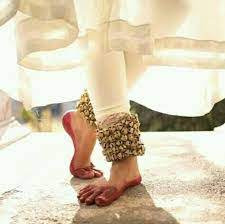
This is what Pav's ankle cuffs most remind me of. It's not the same thing ofc, and idk if the designers were even thinking of this.
But it would be really cool if he was inspired by ghungroos to have cuffs of similar thickness and placement on his legs. Perhaps even familiar to him hmmm?
This is me theorizing HARD to support my headcanon, but combined with Pav's classical dance-n-martial-arts-y moves, i present to you: Pav learning classical dance when he was younger (a thing that a lot of Indian kids do and only a few seriously continue for their lives) is real.
I rest my case
Like yeah it's known at this point that Pav's moves are based a lot off the martial art of kalaripayattu. Which is SO AMAZING AND I LOVE IT SO MUCH!!! But I also think this would be a cool influence alongside that, bc it really feels visible too.
No. 8:
The fact that Pavitr is barefoot is so so important and dear to me!!!
In Indian culture, you're supposed to take your shoes off as a mark of respect, before entering the ranabhoomi (literal transl: battleground, but not in an actual war with swords and shit ofc)
Being barefoot for pujas and in temples and on sacred ground in general is very important
As is being barefoot when you're walking onto a kabaddi or wrestling ground,, basically any fight that's supposed to be important and/or with honour. It's a respect thing for the opponent and for the earth you fight on.
There are a lot of contexts where being barefoot is important or a given
There's the prayer ground bc it's sacred and holy and you can't be dragging your dirty ass shoes there it's super disrespectful. You gotta enter with clean feet specifically, dirty feet are considered disrespectful too. that's also why there wil often be feet washing areas outside of temples here
Then there's the ranabhoomi that I just said, which is more of respect for your opponent and the earth. Respect to the earth especially is very important in the combat forms and sports I know of at least
Then there's the basic respect and tbh the hygiene thing too, of always taking off your footwear before entering another persons house. That one is more flexible, sometimes you can take it off inside, but the done thing is to take them off outside generally. Especially if you're a guest who's not particularly close. You'd be considered really rude if you didn't take them off at all. But again that still varies by person,, the older generations are way stricter abt it
Then the bride thing,,, it's actually a whole small ritual. The bride and groom will enter the groom's house for the first time,, which is considered the bride's new home bc misogynistic tradition so yeah. But basically it's supposed to be an auspicious beginning to a new home and life. (Btw being barefoot during the wedding ceremony is also generally required)
Usually, at least in North Indian tradition, a small vessel of rice is kept at the threshold that the bride must tip over with her foot when entering. It's for prosperity. Then she steps directly into a plate of a red liquid I forget the word for, but it's basically a sindoor paste type of thing. Her first steps into the house must be taken leaving those red footprints behind. That's for auspicious beginning
So Pavitr being barefoot is so so cool from a cultural and a character building standpoint
He takes his job seriously, he does it with respect and honour!!! He seems so chill and happy go lucky, but he's deliberate and respectful abt it!! And he's super connected to his culture too, bc you could just Not and no one would care, but it's so important that he does!!
So yeah!
That has been my full ramble askjasjkas. If you made it this far, have a cookie! Thank you and I hope this was interesting <33

#pavitr prabhakar#atsv pavitr#spiderverse pavitr#spiderman atsv#across the spiderverse#spider man: across the spider verse#character design#rant#starr rambles#analysis#design analysis#character analysis#culture#indian culture#cultural references#pavitr my beloved#myths and legends#chaipunk#goldenpunk#spiderman india#india love#indian#long post
573 notes
·
View notes
Text

I have this exact book: Ghosts, Monsters, and Demons of India by: Rakesh Khanna & J. Furcifer Bhairav for those curious. And yes, sometimes some stories like these exist because of other cultures creating/attributing myths to other places.
Few famous examples: Griffins and the Indus Valley Worm
So Griffins and the Indus Valley Worm are creatures thought to have existed in India by Greek philosophers and scientists of the time. They made up the creatures but believed their origins to be "far exotic and from/to the east" a lot of storytelling has worked this way.
The Three Princes of Serendip (old name for Ceylon/Sri Lanka) is the first story of Serendipity (where we get the word btw) of just fun adventures (slice of life) about three Sri Lankan Princes. Only, it's not Sri Lankan in origin. It's Persian made up for entertainment ABOUT Sri Lanka.
Copy of the book for those interested:

It's a brilliant collection btw.
#Ghosts#Monsters#Ghosts Monsters and Demons of India by: Rakesh Khanna & J. Furcifer Bhairav#demons#Folklore#folktales#myths#myths and legends#indian fantasy#indian culture#indian#Griffins and the Indus Valley Worm#Greek philosophers#Three Princes of Serendip#Ceylon#Sri Lanka#serendipity#Sri Lankan Princes#Persian#global stories#south asian#southeast asian
29 notes
·
View notes
Text
where were you on 2nd august, 2024, when lakshya sen became the first badminton men's singles player from india to make it to the olympic semi finals.
#i was there#i missed a class#and man this was so worth it#do not have the words to describe how fucking proud i am rn#legit started crying#olympics#badminton#mens badminton#india#sports#indian badminton#lakshya sen#LAKSHYA FUCKING SEN!!!#the man the myth the legend the fucking goat
31 notes
·
View notes
Text
I got a copy of Erdoes and Ortiz's American Indian Myths and Legends (1984) for Christmas and it is fascinating to me how various Native American tales portray romance between humans and non-humans. Especially compared to the European takes on that motif, which usually center on the relationship being doomed from the start, because humans belong only with humans. But this does not seem to be the default in the Native American tales in this collection!
There was one story which did portray the relationship as doomed (Tolowim woman and butterfly man, Maidu) and one where a human woman was taken against her will and gladly rescued by her husband (The stolen wife, Tewa). But there is also a tale where a wife is willingly taken by a great buffalo and when her human husband steals her back and kills White Buffalo Chief, she mourns him so that her jealous husband kills her (Apache chief punishes his wife, Tiwa).
That last tale, while tragic, already goes out of its way to show that the woman was happy with the powerful buffalo, and there are four stories in the collection that make a point of ending in happiness:
The industrious daughter who wouldn't marry (Cochiti)
A beautiful young woman who is a master at making beautiful garments spurns all her human suitors, until it is widely known that she doesn't care for young men. Coyote hears of this and goes to court her, dressed in his finest clothes. He does not offer her any gifts, but he dances very well and he brings a branch of blackcurrants, which are her favourite. She is pleased with him, so she takes him home, sleeps with him, and gives birth to two little coyotes. Her parents are dismayed and the other people turn away from her, but Coyote brings her to his home under the ground. There he has all kinds of clothes just as fine as the ones she makes, and she lives there happily with him ever after.
The Serpent of the Sea (Zuni)
The beautiful daughter of the priest-chief of the village Home of the Eagles cannot abide dust or dirt. Every day she spends almost all her time bathing in the sacred spring of the Serpent of the Sea and this angers him. He changes himself into a beautiful baby boy and she finds him and takes him home to care for him. As soon as she falls asleep the Serpent takes his true form again, coiling himself all around the maiden and all around the room. In the morning the whole household panics, but the girl’s father understands what happened and begs the Serpent to let his daughter return to her family once more, even though she now belongs to him. The Serpent moves enough to release her, finally waking her. She is very frightened, but after four days of ceremonies she bids her family goodbye and goes with the Serpent. As they travel the Serpent takes the shape of a beautiful young man, and speaks in a kinder and kinder voice, until she dares to look at him. Startled she asks him where the terrifying creature has gone. He explains that he is the serpent, but that he loves her, and that if she will consent to come and stay with him they will live and love each other forever in the Waters of the World. The maiden goes with him, forgetting her sadness and forgetting her family, and lived with him ever after.
The man who married the moon (Isleta Pueblo)
The great leader, weaver, and medicine man Nah-chu-rú-chu (the bluish light of dawn) got tired of all the young women trying to win his affection. He proclaimed that he would marry the girl who could grind corn meal so fine that it would stick to his pearl water dipper. The only woman who could do it was the Moon, who was an Isleta maiden before she went to live into the sky. He marries her and loves his moon-wife above all things. Two sisters, the Yellow Corn Maiden, are so jealous that they persuade the moon to admire her reflection in the water of the well, and push her in to drown her. The chief mourns so deeply that it no longer rains and all the crops begin dying, until they bring him a mysterious flower from a mound in the forest where his wife disappeared. He performs a sacred ritual and the moon is brought back to life. The corn maidens are changed into helpful, gentle snakes as punishment, and the moon lives happily with her husband.
The woman who married a merman (Coos)
A girl who refuses all her suitors and goes swimming in the creek every day becomes pregnant without understanding how. She gives birth to a baby that always cries unless it is left outside, where someone brings it seal meat to eat. The young mother watches over her baby and at night is approached by a man who says he is her husband and promises she will be safe if she goes with him. The merman takes his wife and child to the bottom of the sea, where many people lived. Her husband was one of the five sons of the village chief and the couple lived there happy and satisfied. She goes to her relatives once to get arrows for her little boy to play with, and once to visit her brothers. The second time they see her shoulders are turning dark and scaly like those of a sea serpent. She never returned again, but sea serpents came into their harbour, and every summer and winter they would send a whale ashore, a gift to their kinsmen above the sea.
Erdoes and Ortiz even draw a parallel between the tale of the Serpent of the Sea and Beauty and the Beast, but I rather love the girl running off with the Coyote and "the woman who married a merman" is such a lovely counterpoint to the selkie and mermaid stories I grew up with. I'm really happy with this book~
#I'm sure I'm missing lots of nuance and details in my synopsis#but this book is pleasant to read and the tales were clearly written with care#so I really recommend going to read these for yourself if they sound like your thing#American Indian Myths and Legends#native american folklore#laura babbles
58 notes
·
View notes
Text

American Indian Myths and Legends
By Richard Erdoes and Alfonso Ortiz.
#American Indian Myths and Legends#Richard Erdoes#Alfonso Ortiz#books#book covers#The Pantheon Fairy Tale and Folklore Library
3 notes
·
View notes
Photo

Asura Zenyatta by ShadowJWu
#zenyatta#Overwatch#Fan Skin#fanskin#ShadowJWu#myth/legend#indian culture#South Asian culture#southeast asian culture
15 notes
·
View notes
Text
#history#manitu#ancient history#indians#indian#ancient#legends#mythical creatures#myth#myths#legend#legendary creatures#hindu
0 notes
Photo

How Death Came into the World (Modoc Legend)
How Death Came into the World is a legend of the Modoc nation whose ancestral lands once covered the region of modern-day northeastern California and southern Oregon, USA. Their story of the origin of death shares many similarities with those of other Native peoples of North America as well as with the ancient Greek myth of Orpheus and Eurydice.
Pit River Valley, Modoc County, California
Robert F. Ettner (Public Domain)
The Modoc were 'discovered' by Euro-Americans c. 1820 in their ancestral lands of what is now southern Oregon and northern California. They are described by the American ethnographer James Mooney (l. 1861-1921) as a small band who were culturally isolated, which makes the similarities between How Death Came into the World and the Orpheus/Eurydice myth all the more interesting.
The Modoc had been living in the region for approximately 14,000 years before the arrival of the Euro-Americans but, by 1864, had been forcibly relocated to reservations, eventually two separate ones in the territories of modern Oklahoma and Oregon. They retained their stories, however, including How Death Came into the World, which is still told today.
The main character of the tale, Kumokums, is the Creator God of the Modoc (also known as Kemush, Kumokum, Kumush, Koomookumpts, Gmukamps) and his name is translated as "Old Man of the Ancients" or "Primeval Old Man", suggesting his existence from the beginning of time. In one version of the Modoc Creation Story, Kumokums travels to the Land of the Dead to select the spirits that would animate the people of four tribes of the region: the Shasta, the Warm Springs, the Klamath, and the Modoc. In How Death Came into the World, he again travels to the Land of the Dead but, this time, to bring back the spirit of his recently deceased daughter.
Native American Death Origin Myths
Native American origin myths concerning death are remarkably similar, even when the nations have had no known contact with each other prior to Euro-American contact and efforts to synthesize cultural beliefs as expressed in Native American literature. Scholar Larry J. Zimmerman writes:
Most accounts of the origin of death accept the logic that space is limited on Earth and room needs to be made for new life. On the whole, the afterlife is regarded as a place much like this one but with more game, corn, or whatever was prized…Almost all Indian peoples believed in some plane of existence beyond the realm of the living, but descriptions of the afterlife differed greatly, and the issue of what happens to the soul after death was a highly complex one for many tribes.
(246)
As Zimmerman notes, there was no doubt – for many, if not all Native American nations – that the soul survived physical death and went on to another realm, but that did very little to help a survivor deal with the grief of their loss. Native American origin myths concerning death tried to assist with that by explaining how death came to be and how even those responsible for the decision suffered the same grief at their loss.
The basic paradigm involves a figure of some degree of authority who makes a decision concerning mortality, then loses someone close to them, and wishes to reverse their earlier judgment – but, once the choice has been spoken into existence, it cannot be taken back.
Modoc Harvest Diorama
Michael Barera (CC BY-SA)
The Kiowa of the Plains Indians culture have a similar tale, sometimes given as How Death Came into the World and sometimes as Why the Ant is Almost Cut in Two, which follows this same model. In that story, the trickster figure Saynday (well-known from the Saynday tales) interacts with Red Ant as they discuss mortality and Saynday's concept of resurrecting the dead after four days. Red Ant rejects his proposal, claiming there are already too many living things on the earth and death is necessary to make room for those yet to be born or already living. Saynday agrees with her and decrees death as the final chapter of life on earth but, when Red Ant's son is killed, her grief is so intense she tries to kill herself, wishing she could have back what she had lost.
The Shoshone (Shoshoni) nation has a similar tale in which the central characters are Wolf and Coyote. Wolf suggests that death should be only a temporary state, which one could return from if the living enact a certain ritual that includes shooting an arrow beneath the deceased. Coyote rejects this plan, noting that there would then be too many of the living and resources would be spread too thinly. Wolf accepts Coyote's suggestion and decrees death as a permanent state, but when Coyote's son is killed, he comes to Wolf and asks that the decision be reversed. Wolf then reminds him that it was Coyote himself who insisted on death as a permanent state and that decision cannot now be altered.
Other Native American nations have similar origin stories for death, but the Modoc tale is unique in that it also provides an explanation of why the people had winter and summer camps, how their calendar was devised, and a detailed description of the Land of the Dead.
The story is also of interest to anthropologists, historians, and literary scholars for its similarity to the story of Orpheus and Eurydice from Greek mythology, which makes it stand out; as scholar Alice Marriott phrases it, "the Orpheus-Eurydice theme is unusual in North American Indian mythology" (190). There is no known record of interaction between the Modoc and anyone who would have known the Orpheus/Eurydice tale prior to contact between the Modoc nation and Euro-Americans, and How Death Came into the World is understood to pre-date that time as it seems to have already long been a part of the Modoc oral literary tradition.
Continue reading...
62 notes
·
View notes
Text
Legend VS LMK
Nüwa

Legend:
Name:
Mother Goddes, and Member of the Three Sovereigns of Chinese Mythology. The sister and wife of Fuxi. Nuwa is considered the goddess of creation and the female emperor of mankind. Her reverential name is Wahuang (Chinese: 媧皇; lit. 'Empress Wa'). That is due to Nuwa’s position of honor in the Chinese pantheon, Nuwa was given a character completely unique to her name – Wa. Nu is the character of woman and is often used as a prefix for goddesses.

Shes is a godess in Chinese folk religion, Buddihsm, Confucianism and Taoism
She is one of the most venerated Chinese goddesses alongside Guanyin and Mazu.
Origin:
Nuwa was created by her mother, the goddess Huaxu. While wandering the heavenly realms, Huaxu stepped into the footprint of the god of thunder Leigong and suddenly became pregnant. In the earliest versions of the myth, Huaxu gave birth in the earthly realm to only Nuwa.
In later versions, Huaxu gave birth to Nuwa and Fuxi. Nuwa and Fuxi were born with the bodies of snakes and the faces of humans, however, they could shapeshift into humanoid figures with two legs and a tail.
Nüwa & Fuxi Appearances:
The iconography of Fuxi and Nüwa vary in physical appearance depending on the time period and regional differences. In tomb murals and iconography, Fuxi and Nüwa generally have snake-like bodies and human faces or heads.
Nüwa is often depicted holding a compass or multiple compasses, which were a symbol of a dome-like sky. She was also thought to be an embodiment of the stars and the sky or a star god.
Fuxi and Nüwa can be depicted as individual figures arranged as a symmetrical pair or they can be depicted in double figures with intertwined snake-like bodies. Their snake-like tails can also be depicted stretching out towards each other. This is similar to the representation of Rahu and Ketu in Indian astrology.

As some tales of Nüwa and Fuxi, both sprang from the same mother at the same time, Taoists believed that Nuwa was the primordial personification of yin energy (female, gentle, intuitive, and receptive) and Fuxi was representative of the yang (male, fast, active, fierce). Coming together symbolized the reunion of the yin and yang energies which then united to create human existence.
Fuxi and Nüwa can also appear individually on separate tomb bricks. They generally hold or embrace the sun or moon discs containing the images of a bird or a toad (sometimes a hare) which are the sun and moon symbolism respectively. Them holding the sun and the moon appear as early as the late Western Han dynasty.

Other physical appearance variations, such as lower snake-like body shape, depictions of legs. and wings with feathers that protrude from their backs as found in the late Western Han Xinan Tomb or smaller quills found on their shoulders, and in hats and hairstyles.


the Gansu murals dating to the Wei and Western Jin period, one of the most typical features of Fuxi is the "mountain-hat" which looks like a three-peaked cap while Nüwa is depicted wearing various hairstyles characteristic of Han women. Both deities dressed in wide-sleeved clothing, which reflects the typical Han clothing style also commonly depicted in Han dynasty art.
Nüwa and Fuxi Other Stories:
In one version of their myth, soon after the birth of Nuwa and Fuxi, a great flood struck the earth, and only Nuwa and Fuxi remained unharmed after escaping by boat. As the years passed, and with only each other to keep themselves company, Nuwa and Fuxi longed for companionship. Unwilling to violate the laws of heaven by sleeping together as brother and sister, they prayed together seeking a sign of approval.
As they were the only humanoids of their kind left upon the earth, the Emperor of Heaven accepted their union. After mating, Nuwa gave birth to humanity, becoming the matriarch of mankind by giving birth to a ball of meat. Nuwa and Fuxi then divided the meat into pieces shaped as humans and scattered them across the world.
In another version of the creation tale, found in the Classic of Mountains and Seas, Nuwa and Fuxi lived upon legendary Kunlun Mountain. Trying to keep warm on a cold night, the twins created two fires. As the fires burned, they eventually became one. While watching the fires merge, Nuwa and Fuxi joined together as husband and wife. Deciding that they would like to have children, they molded clay into the shape of humans. Using their powers to imbue the small figurines with life, Nuwa and Fuxi created humanity.
Duyi Zhi volume 3, written by LiRong over a thousand years ago, gives a slightly different account of the Chinese creation myth – “There was a brother and a sister living on the Kunlun Mountain, and there were no ordinary people at that time. The sister’s name was Nuwa. The brother and sister wished to become husband and wife but felt shy and guilty about this desire. So the brother took his younger sister to the top of the Kunlun Mountain and prayed: “If Heaven allows us to be man and wife, please let the smoke before us gather; if not, please let the smoke scatter.” The smoke before them gathered together. So Nuwa came to live with her elder brother. She made a fan with grass to hide her face. (The present custom of women covering their faces with fans originated from this story).”
"But most versions give sol credit of humanity's creation to Nuwa. But in some of those Fuxi is credited with introducing a number of innovations and inventions that made significant improvements to the lives of his wife’s beloved creations. One of these, for instance, is the invention of fishing and domesticating animals. "
Creation:
After the goddess Hauxu gave birth to Nuwa, Nuwa roamed the earth alone. The earth was young and teeming with life, filled with blossoming trees and flowers. The lush grounds were covered with many types of animals, the skies were filled with birds, and the seas were full of fish. But while the earth was beautiful, Nuwa felt very lonely, despairing that there was no one to accompany her.
While walking one day, Nuwa was struck by the idea of creating living beings herself. First, she made a new type of bird that could not fly away from her by creating chickens. Then she wanted to make an animal that would be a constant companion, and Nuwa created dogs. On the third day, she made sheep. Then pigs. Then cows. On day six, Nuwa made horses On day seven, while Nuwa walked along a riverbank, she stopped to admire her reflection. As she stroked the hair from her face, she was struck with inspiration and thought to make life forms that looked like her. Nuwa began to scoop and mold yellow clay into figures that had arms and could stand upright upon legs. As she worked the mud in her hands, the figures came alive and began to move and speak. Soon, the creations began to sing and dance around Nuwa while honoring her. All of the loneliness Nuwa had known went away.
Thrilled at her results and filled with passion for her creation, Nuwa desired to make more humans faster. She realized that she could drag rope across the mud and mass produce them, as creating every person individually was beginning to take too much time and hurting her hands. Soon she began to whip the rope, flinging mud and making people faster and faster.
The people Nuwa molded by hand became the wealthy nobility. The ones she made by dragging the rope became commoners. And finally, the ones Nuwa made by whipping the rope became the servant class. As she finished making the last batch of humans it began to rain. Because some of these figures had not yet dried, the rain began to mark them and melt them. The last batch of humans that Nuwa created were damaged by the rain, and thus were the ancestors of those with sickness and deformities.
"She molded humans individually by hand with yellow clay. In other stories where she fulfills this role, she only created nobles and/or the rich out of yellow soil. The stories vary on the other details about humanity's creation, but it was a tradition commonly believed in ancient China that she created commoners from brown mud."
The Pillars:

One of the enduring myths of Nuwa is that of the repairing of the Pillar of Heaven. In the early days of earth’s existence, The earth was separated from the sky by four large pillars which had once been the arms and legs of the creator god, Pangu.
During these early days, the god of water, Gong Gong, and the god of fire, Zhu Rong, had been at odds for many years. Unable to hold back their fury at one another, they engaged in battle to determine who would be the god of the heavens. As they fought, fires raged and floods began to destroy the new earth.
Gong Gong was finally subdued by Zhu Rong, but in his rage, he slammed his head against Buzhou Mountain, one of the four pillars of heaven that had once been Pangu’s leg. An earthquake shook the earth, and the pillar collapsed tearing a hole in the skies.
Looking upon the earth, Nuwa was filled with compassion for her children who were suffering. The new creation of earth had been torn to shreds from the battle between the water and fire gods. Fires burned out of control and water poured in a deluge from the hole in the sky. Nuwa desired to help her children, so she sought out the sky turtle, Ao.
Nuwa threw herself at Ao’s mercy, hoping for a miracle to save her many children. The sky turtle, feeling compassion for the mother of humanity, took Nuwa’s sword and cut off one of his legs, offering it as a substitute pillar. After leaving Ao, Nuwa collected five colored stones (red, yellow, blue, white, and black) and melted them together to repair the hole in the heavens, while using Ao’s leg to replace the pillar.
( The five-colored stones symbolize the five Chinese elements (wood, fire, earth, metal, and water)
Waters poured on her relentlessly as she pushed the leg into position, and once in place, she shoved the ashes of burnt reeds into the remaining holes to plug the leaks. After replacing the pillar and stopping the deluge, Nuwa fell exhausted upon the earth and died.
While many are familiar with the Chinese myth of the Three Sovereigns and Five Emperors, some areas of south China revere Nuwa as one of the Three Sovereigns, reigning as Empress Wa after the death of Fuxi and the rise of Shennong.
Tying into China’s strong ancient matriarchal beliefs, after the reign of Fuxi, the Empress Wa’s rule was challenged by a neighboring tribal chieftan. After defeating the chief in battle, Nuwa dragged her enemy to the peak of Mount Buzhou. Filled with shame, the chief banged his head upon the mountain, tearing a hole in the sky.
As the waters poured from the heavens, the entire world soon flooded, killing all of creation except for her army which was protected by her godhood. Nuwa then found five colored stones and melted them together, patching the hole in the sky.
In other versions of the Pillar of Heaven myth, when Nuwa attempted to fix the sky with the five melted stones she soon found that there was not enough to fix the hole in the sky. Knowing there was no other choice, Nuwa used her own body to fix the remaining hole, sacrificing her life to keep her children safe. With the hole repaired the deluge ended, and humanity was able to thrive and multiply again.
"In all of the myths of the repair of the Pillar of Heaven, due to Ao’s leg being slightly shorter than the original pillars, Nuwa could not align the sky and earth the same as they were before. The sky slanted to the northwest. The earth slanted southeast.
Since the repair, the sun, moon, and stars all rise from the east and set to the west, and all of the rivers in China flow southeast. And due to the use of the multi-colored stones, the clouds of heaven now had different colors."
Other:
In southwest China, many of the minority groups still celebrate Nuwa as their primary goddess and honor her with the yearly Water-Splashing Festival. There are many temples to Nuwa and Fuxi, but the largest temple to the pair lies in Hebei Province, believed to be the ancestral home of all humanity.
The Classic of Mountains and Seas, dated between the Warring States period and the Han dynasty, describes Nüwa's intestines as being scattered into ten spirits.
In Shuowen Jiezi (c. 58 – 147 AD), China's earliest dictionary, under the entry for Nüwa author Xu Shen describes her as being both the sister and the wife of Fuxi. Nüwa and Fuxi were pictured as having snake-like tails interlocked in an Eastern Han dynasty mural in the Wuliang Temple in Jiaxiang county, Shandong province.
In the collection Four Great Books of Song (c. 960 – 1279 AD), compiled by Li Fang and others, Volume 78 of the book Imperial Readings of the Taiping Era contains a chapter "Customs by Yingshao of the Han Dynasty" in which it is stated that there were no men when the sky and the earth were separated. Thus Nüwa used yellow clay to make people. But the clay was not strong enough so she put ropes into the clay to make the bodies erect. It is also said that she prayed to gods to let her be the goddess of marital affairs.
In Ming dynasty myths about the transition from the Shang dynasty to the Zhou dynasty, Nüwa made evil decisions that ultimately benefited China, such as sending a fox spirit to encourage the debauchery of King Zhou, which led to him being deposed. Other tales have her and Fuxi as exclusively the "great gentle protectors of humanity" unwilling to use subterfuge Another telling of that story is from the famed Ming Dynasty novel Fengshen Bang. Nüwa is revered since Xia dynasty for creating the five-colored stones to mend the heavens, which tilted after Gonggong toppled one of the heavenly pillars, Mount Buzhou. Shang Rong asked King Zhou of Shang to pay her a visit as a sign of deep respect. Upon seeing her statue, Zhou was completely overcome with lust at the sight of the beautiful ancient goddess Nüwa. He wrote an erotic poem on a neighboring wall and took his leave. When Nüwa later returned to her temple after visiting the Yellow Emperor, she saw the foulness of Zhou's words. In her anger, she swore that the Shang dynasty would end in payment for his offense. In her rage, Nüwa personally ascended to the palace in an attempt to kill the king, but was suddenly struck back by two large beams of red light. After Nüwa realized that King Zhou was already destined to rule the kingdom for twenty-six more years, Nüwa summoned her three subordinates—the Thousand-Year Vixen (later becoming Daji), the Jade Pipa, and the Nine-Headed Pheasant. With these words, Nüwa brought destined chaos to the Shang dynasty, "The luck Cheng Tang won six hundred years ago is dimming. I speak to you of a new mandate of heaven which sets the destiny for all. You three are to enter King Zhou's palace, where you are to bewitch him. Whatever you do, do not harm anyone else. If you do my bidding, and do it well, you will be permitted to reincarnate as human beings." With these words, Nüwa was never heard of again, but was still a major indirect factor towards the Shang dynasty's fall.
Nüwa and Fuxi were also thought to be gods of silk
LMK:
Long ago, Nüwa sculpted humanity out of clay and mud. She believed her children would not survive the primordial sea of chaos, so she built the Pillar of Heaven and forged the cycles to protect them. But, a cataclysmic event left the pillar shattered. Nüwa crafted five-colored stones and reconstructed the pillar back to its original state. She entrusted four stones to the Four Symbols: the Vermillion Bird, the Black Tortoise, the White Tiger, and the Teal Dragon, the final one to be guarded by the Jade Emperor. After Monkey King's birth, Nüwa repurposed his stone to carry the Harbinger of Chaos. She was saddened by the creature's existence to sacrifice himself but knew that this was a necessary sacrifice to keep her children safe from the chaos beyond.
Thoughts:
Throughout the whole research into her real-world mythology. She has been credited for creating a few animals though monkeys are not mentioned that could be just my research or something else. But I actually found something similar to her pillar story number 3 that nearly matches the LMK version of her fixing the pillars. She was never in the JTTW. But some other thoughts on Nuwa and the pillars I think when she fixed the pillars she accidentally made Wukong. I don't remember where I read this but I think there was a version of JTTW that had the Jade Emperor say something about " Made with the essence of fragments of Godess Nuwas Power" Even if that might not be what I remember right. Maybe it could be in the LMK universe when the crew fought the Nine-headed demon, he used his chaos powers to bind them to certain sections of the wall.


MK is placed over his mural self, the silhouette of his destiny. And the others are placed over the sotnes that would later be them when they smashed them.

But then look at Wukong who is placed in Nuwas hand in the mural of her molding and creating humans.
This could be foreshadowing that it might be revealed and it might hold something of importance later. It might also explain why the goddess chose Wukong as the templet for her harbinger of chaos.
Other Media:
She does appear in the film "The Monkey King: Havoc in Heaven's Palace" and "Journey to the West II", both of which feature Nüwa creating Sun Wukong using one of the five-colored stones. The former film also features Nüwa sacrificing herself to rebuild Heaven, similar to her actions previous to Season 5.
Thnak you for reading if you have something i missed please leave it in the comments thank you :)
99 notes
·
View notes
Text








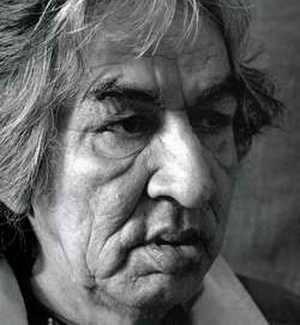
Norval Morrisseau, CM (1932 – 2007), also known as Copper Thunderbird, was an Aboriginal Canadian artist. Known as the "Picasso of the North", Morrisseau created works depicting the legends of his people, the cultural and political tensions between native Canadian and European traditions, his existential struggles, and his deep spirituality and mysticism. His style is characterized by thick black outlines and bright colors. He founded the Woodlands School of Canadian art and was a prominent member of the “Indian Group of Seven”.
An Anishinaabe, he was born March 14, 1931 on the Sand Point Ojibway reserve near Beardmore, Ontario. Some sources quote him as saying that he was born in Fort William, now part of Thunder Bay, Ontario, on the same date in 1931. His full name is Jean-Baptiste Norman Henry Morrisseau, but he signs his work using the Cree syllabics writing ᐅᓵᐚᐱᐦᑯᐱᓀᐦᓯ (Ozaawaabiko-binesi, unpointed: ᐅᓴᐘᐱᑯᐱᓀᓯ, "Copper/Brass [Thunder]Bird"), as his pen-name for his Anishnaabe name ᒥᐢᒁᐱᐦᐠ ᐊᓂᒥᐦᑮ (Miskwaabik Animikii, unpointed: ᒥᐢᑿᐱᐠ ᐊᓂᒥᑭ, "Copper Thunderbird").
In accordance with Anishnaabe tradition, he was raised by his maternal grandparents. His grandfather, Moses Potan Nanakonagos, a shaman, taught him the traditions and legends of his people. His grandmother, Grace Theresa Potan Nanakonagos, was a devout Catholic and from her he learned the tenets of Christianity. The contrast between these two religious traditions became an important factor in his intellectual and artistic development.
At the age of six, he was sent to a Catholic residential school, where students were educated in the European tradition, native culture was repressed, and the use of native language was forbidden. After two years he returned home and started attending a local community school.
At the age of 19, he became very sick. He was taken to a doctor but his health kept deteriorating. Fearing for his life, his mother called a medicine-woman who performed a renaming ceremony: She gave him the new name Copper Thunderbird. According to Anishnaabe tradition, giving a powerful name to a dying person can give them new energy and save their lives. Morrisseau recovered after the ceremony and from then on always signed his works with his new name.
Morrisseau contracted tuberculosis in 1956 and was sent to Fort William Sanatorium to recover. There he met his future wife Harriet Kakegamic with whom he had seven children, Victoria, Michael, Peter, David, Lisa, Eugene, and Christian.
After being invited by Ontario Provincial Police Constable, Robert Sheppard, to meet the artist, the anthropologist Selwyn Dewdney, became an early advocate of Morrisseau's and was very interested in Morrisseau's deep knowledge of native culture and myth. Dewdney was the first to take his art to a wider public.
Jack Pollock, a Toronto art dealer, helped expose Morrisseau's art to a wider audience in the 1960s. The two initially met in 1962 while Pollock was teaching a painting workshop in Beardmore. As Pollock did not drive, Susan Ross whom Morrisseau had met in 1961 and Sheila Burnford drove Pollock to visit Morrisseau at his home to view more of his works. Immediately struck by the genius of Morrisseau's art, he immediately organized an exhibition of his work at his Toronto gallery.
This is a part of the Wikipedia article used under the Creative Commons Attribution-Sharealike 3.0 Unported License (CC-BY-SA). The full text of the article is here →
48 notes
·
View notes
Text
Lily and James — the alchemical Queen and King. Lily is the main symbol of the entire saga.
In Harry Potter, there are two levels - the mundane and the symbolic. On the mundane level, Lily is a character with her own strengths and weaknesses. On the symbolic level, Lily is the main symbol of the entire saga. Perhaps that's why there's so little talk about her because symbolically Lily is what everyone strives for, everyone searches for but cannot find. Harry learns more about Lily only before the final battle, and there's a reason for that.
It's no secret that HP books are heavily laden with alchemical and Christian symbolism. I'm not religious, and to me, all these symbols are just cultural codes that have had a significant influence on almost all classic literature and art.

Philipp Otto Runge, Chagall, Goethe — they're all alchemical codes
Firstly, alchemy is not about literally turning lead into gold, it's a path of spiritual development, a path of transformation, a "hero's journey," the journey of the Son returning to the Father. Alchemical transformation is described in the text "The Chymical Wedding of Christian Rosenkreutz." This is the third manifesto of the Rosicrucian Brotherhood.
So, lilies are a very ancient symbol.
According to Jewish legends, the lily grew in Eden just at the time of Eve's temptation by the devil and could be defiled by him, but even amid temptation, it remained as pure as it was, and no dirty hand dared to touch it. In early medieval depictions, Christ was placed against a backdrop of lilies or in the lily flower, seen as a symbol of the Virgin Mary. The orange lily often symbolizes the blood of Christ.
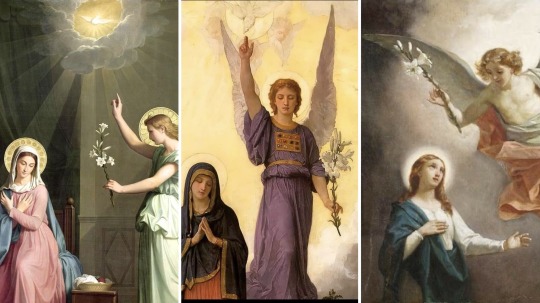
Symbolically, Lily is the love of God, a divine spark, and the blood of Christ itself, which was shed in the name of redemption and salvation to atone for the sins of all humanity. And what is the blood of Christ? In Christian tradition, the blood of Jesus Christ is a symbol of the life-giving and saving spirit of God.
By the way, lilies and roses were often confused in translations, and symbolically they are the same. Many suspected that the Rosicrucians' rose is a stylized version of the Egyptian and Indian flowering lotus, and the lotus has often been considered a water lily (they are different, but symbolically they merged). But calling the main character Rose would be too dull and obvious a reference.
Lily - symbolically, she is both the mother of Christ and the Spirit of God herself, the bearer of divine love, to which all seekers are drawn. This is not the only meaning, but for now, it's enough.
God is love, says John the Apostle. (Remus John Lupin, hehe. It was absolutely unnecessary to know his middle name. It's intentionally inserted because each of the marauders, except Sirius, by name signifies one of the disciples closest to Christ. Sirius is a separate story, he signifies something completely different.)
And who is drawn? Well, primarily we see two - James and Snape.
One of the most important things we learn about James is that he's a deer. The deer is a well-known symbol. In myths and folk beliefs, the deer was associated with the soul's aspiration to heaven and purification.
"As the deer pants for streams of water, so my soul pants for you, my God" Ps. 42: 1
In the Alexandrian "Physiologus," there's an ancient enmity between the stag and the serpent. The serpent hides from the foe in the clefts of the earth, but the stag, with the help of water, draws out the serpent and defeats it. (Water has always been a symbol of the serpent, even in Slytherin's element water, but the stag fights the serpent not with ordinary water but with the water of baptism. The snake has another important meaning for alchemy, but more on that later.)
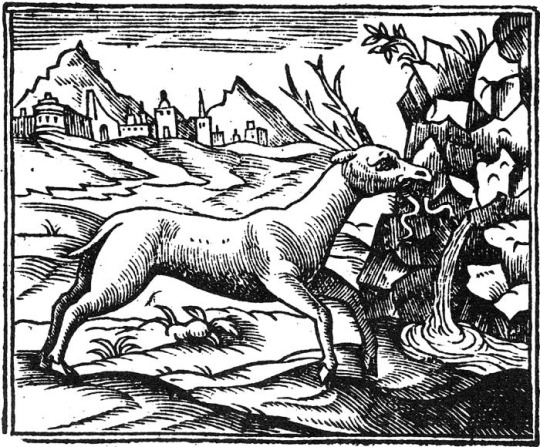
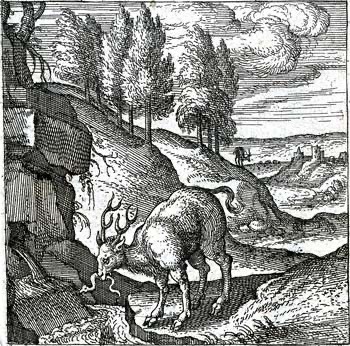
Snape belongs to the Serpent, to secret knowledge, occult knowledge, "philosophical" reason, dark magic, which has always been contrary to the divine nature in Christian understanding and originated from the devil. James belongs to the Lion and the Deer.
The Lion is a typical alchemical symbol. Also, the Red Lion is Christ. Gryffindor embodies the soul's aspiration towards light and transformation, towards salvation. By the way, St. Godric (the hermit) also had his own pet deer, which he saved.
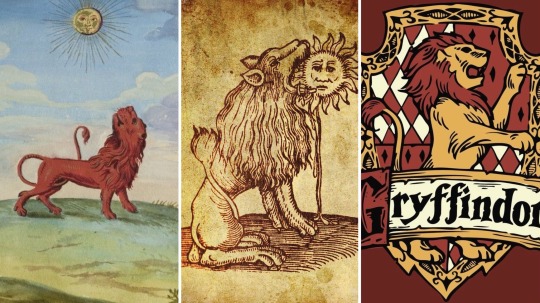
The deer seeks love, the spirit of God, the divine spark, God Himself, and in this persistent pursuit is shown James's path, as a seeker and as an alchemist. The Potters — if not alchemists themselves, then at least from the lineage of alchemists — the Peverells (The symbol of the Deathly Hallows is an alchemical-masonic symbol). And this means that the Potters are at least seekers; in their souls, there is a desire to find the divine and undergo transformation. The Potters have a strong hatred for the 'serpentine essence' of evil, and this is what needs to be transformed. (By the way, the graveyard is located near St. Jerome's Church. Besides translating the Bible into Latin, Jerome also healed and tamed a lion).
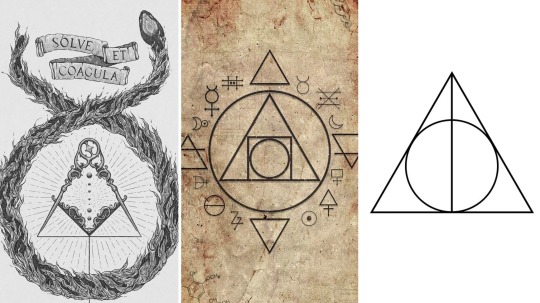
Masonic-alchemical symbol. Symbol of the philosopher's stone. Symbol of the Deathly Hallows. Solve et coagula is a principle of alchemy meaning "dissolve and coagulate".
An alchemist is a gardener, and this is another interesting reference to James and Lily. The way James tries to find an approach to Lily is an alchemical process. The alchemist tends to the Garden. In Vrisvik's Great Work (the Magnum Opus), it appears as the Garden of the Wise. The Gates to the Garden of the Wise for the Chosen become the process of dissolving "our Substance." James manages to approach Lily only when he dissolves his Ego. The Ego is the main enemy on the path to transformation.
The tradition of "hermetic gardening," that is, "cultivating the flowers of Wisdom in one's garden," becomes a leading line in alchemical symbolism. James cultivates wisdom.
While Snape cultivates "dark knowledge," although his soul also strives for light and love. But Snape is still too captured by his Ego, too captivated by base emotions, a thirst for revenge, recognition, or power, a craving for "secret knowledge." He cannot resist it, no matter how much he may strive for Lily, for the divine transformation of his spirit, and James, still dwelling in his Ego, instead of showing mercy to Snape, pushes him further away. The stag fights the serpent, but God is love. Ultimately, Snape temporarily closes off the paths of alchemical transformation for himself.
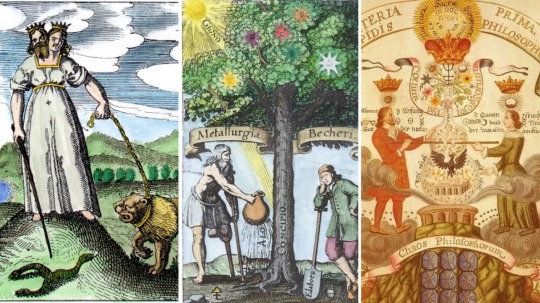
The Rebis is the end product of the alchemical magnum opus or great work. The lion must dissolve the serpent. Hermetic gardening. The alchemical wedding: the Queen and the King.
But besides all this, the deer is also a symbol of eternal renewal and victory over death ("The last enemy that shall be destroyed is death" 1 Corinthians 15:26 ). A symbol of Christ. His constantly renewing antlers represent eternal life.
In the original Greek of the New Testament, the names Jacob and James are variants of the same root—Yaaqob. James is an active force, a seeker, an investigator, a supplanter. James the Great was of a rather impulsive character, but everyone was also amazed by his courage, he was the only one who acknowledged Christ as the Messiah. And he is the only apostle whose death is described in the New Testament. He dies at the hands of King Herod, a cynical and evil king who was willing to murder babies for his purpose. James also dies at the hands of Voldemort, who is willing to kill a baby for his purpose.
Moreover, it was Saint James who was considered the heavenly patron of alchemists. His tomb was located in Santiago de Compostela, which was the oldest center of adepts. It was there, in 1378, after twenty years of unsuccessful attempts to decipher the Book of Hieroglyphic Figures, that Nicolas Flamel, the most famous alchemist of the Middle Ages, went. By the way, Shell Cottage... the scallop shell is a symbol of the apostle James and the "trademark" of the Way of St. James. Shell Cottage is also alchemical. It is there that Harry sees the symbol of the Deathly Hallows around Lovegood's neck.
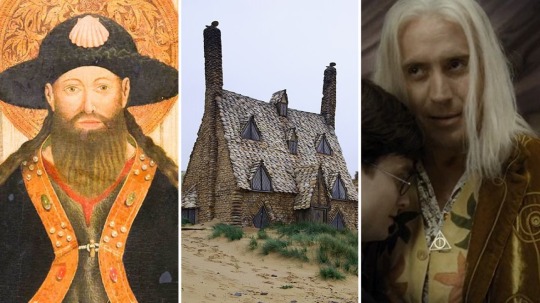
James is a seeker. Lily is a symbol of the divine spirit, sparks, transformation. That to which all must ultimately come, that which must change in our world in the image of God. But for now, our world is seized by evil, by the antichrist. To defeat death means to defeat the antichrist in one's soul.
James finds Lily. The Soul finds the Spirit. The Spirit descends into the Soul. The King and Queen marry—and a new life is born, another hero capable of defeating the evil that has engulfed the world, capable of cleansing the world of evil. The connection between Harry and Christ is no secret to anyone.
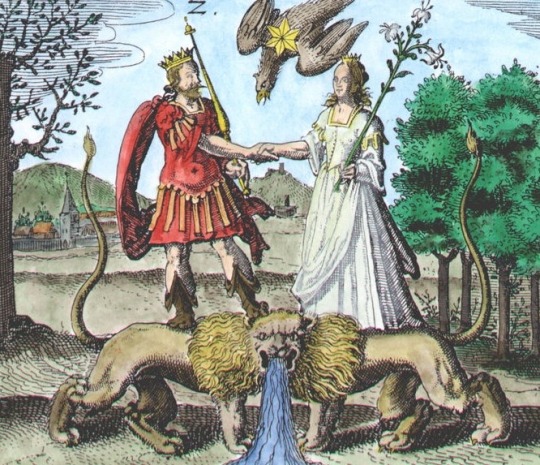
The power of love conquers death. A rune appears on Harry's forehead—Sowilo rune—the victory rune, the sun rune, the irreversible rune. It symbolically serves as the key to the world of Alfheim—the world of the light elves, that is, the bright ideas, the prototypes of the buddhial plane, the ideality in this world.
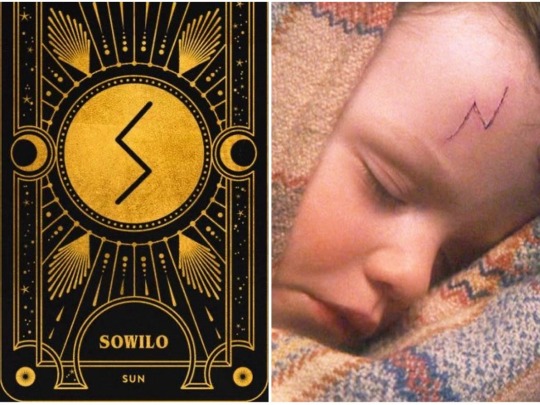
The key to God. Harry becomes marked. His scar is a reminder to him that he came into this world not just by chance, but to destroy evil. And coming into this world, materializing, a person invariably receives a particle of the antichrist within himself. That's how this world works. Evil is in the soul of each of us, and through the Great Work, a person must purify himself.
And none can live while the other survives, because they mutually exclude each other by their very nature. Christ and antichrist.
But Harry has a difficult path ahead, the path of the Great Work before he can achieve victory. And that will be the theme of all 7 books, 7 years — exactly 7 days is the duration of The Chymical Wedding of Christian Rosenkreutz for the transformation oh his soul, for victory over death.
128 notes
·
View notes
Text
The demon, Hiranyakashipu, and the Welsh hero, Lleu Llaw Gyffes -- what do they have in common?


Well, something I've talked a lot about before in some other threads that can be boiled down (a touch unfairly and we'll get into that) into the myth/trope of impenetrability or weakness. The idea of a character (usually a hero, sometimes a villain/monster) having "NO" weaknesses (terms and conditions apply - see: they have ONE you just might not know it).
So, Lleu Llaw Gyffes, Welsh hero, he cannot be killed during the day or night, nor indoors or outdoors, neither riding nor walking, not clothed and not naked, nor by any weapon lawfully made.
Interestingly enough Hiranyakashipu has a very similar condition - the demon, manages to get a boon from the creator god, Brahma at first he asks for immortality, which he is denied. However, he manages to sort of work his way there with a loophole (only...that loop was certainly holed back at him - as it often is in old epics and tales).
He wished that he could not meet death by any living entities created by god, that he could not fall during true day time or night, nor on the ground or sky, or by animal or man, and he continues to lay his conditions as such can't be killed by a god, or a demon, or a snake from a lower plane of existence.
Only...enter Vishnu, a god who is not Brahma who did not create the demon, or others. To get around this, Vishnu becomes the incarnation and avatar of himself, Narasimha

Not mortal man, or god, or demon, or full animal. But something between them all, he grabs the demon and places him on his lap - thus he is no longer in the sky or ground, and it is done at twilight (not day or night but between - the transition), and he rips him apart with his clawed hands - not a made weapon, but something natural. Both Lleu Llaw Gyffes and the demon Hiranyakashipu had progenitors and thus grandfathers.
Interestingly enough Lleu is the grandson of: Beli Mawr or Beli the Great. Our demon is the descendent of Mahabali or Bali Maharaj - Bali the Great, Bali the King (demon king in this case).
Now, I've talked about the similarities of myths and tropes and beats in epics and tales out of these two (and other cultures) before and it's likely owing to shared P.I.E. (proto indo european) origins backed up by shared genetic ancestry scientists have discovered linking Indians and Celts to the P.I.E group not to mention the etymological similarities. The differences here are one is a hero, and thus his weakness is not exploited in full and he doesn't die.
Going back though, we have German story of Siegfried the dragonslayer, who bathes in the blood of Fafnir after killing him (due to a broken scale/exposed weakness in the armor - hi smaug), and thus himself gets invulnerable/impenetrable skin (terms and conditions apply) where the leaf of a linden (lime tree) sticks to his back preventing it from being coated in protective dragon's blood. Later his lover is tricked into divulging his weak spot (something similar happens to Lleu only he survives) and in this case Siegfried is killed.
This is just one of many connections in shared myths around the world/tropes/beats and how other parts play out differently (some cultures also just love taking things to a much darker place - stares). LIGHTEN UP A LITTLE.
Anywhoooo there's a small fun little myth.
#Hiranyakashipu#Lleu Llaw Gyffes#welsh folklore#Welsh mythology#Welsh myths#Welsh legends#Brahma#Loophole#folklore#folktale#stories and myths#mythology#mythological creature#vishnu#Narasimha#Beli Mawr#Beli The Great#Mahabali#Bali Maharaj#celtic folklore#indian folklore#myths and legends#Siegfried the dragonslayer#Fafnir#tropes#world myths#world mythology
19 notes
·
View notes
Text
i maintain that vishnu is way more boring than shiva BUT he gets major points from me for being mohini one time

she's an enchanting damsel who does seduction tricks! she seduces shiva!

A Mattancherry palace mural shows Shiva and Mohini in an embrace while Parvati seated on Nandi, the white bull, looks at them in distaste.[27]
parvati watching from nandi the cuck bull
Another South Indian folktale tells of the Mahabharata hero Aravan (who becomes the Tamil god Kuttantavar), who was married to Mohini, before his self-sacrifice. Aravan agrees to become the sacrificial victim for the Kalappali ("sacrifice to the battlefield") to ensure the victory of the Pandavas, his father, and his uncles. Before being sacrificed to goddess Kali, Aravan asks three boons from Krishna, the guide of the Pandavas. The third boon was that Aravan should be married before the sacrifice so that he could get the right of cremation and funerary offerings (bachelors were buried). This third boon, however, is found only in the folk cults. To fulfill this wish in the Kuttantavar cult myth, Krishna turns into Mohini, marries Aravan, and spends the night with him. Then after the sacrifice, Mohini laments Aravan's death, breaking her bangles, beating her breasts, and discarding her bridal finery. She then returns to the original form of Krishna.[51] The legend of the marriage of Aravan and Krishna in his female form as Mohini, and Mohini-Krishna's widowhood after Aravan's sacrifice, forms the central theme of an eighteen-day annual festival in the Tamil month of Cittirai (April–May) at Koovagam. The marriage ceremony is re-enacted by transgender Hijras, who play the role of Mohini-Krishna.[52]
! the tragic sacrifice of the transgender-wife guy
32 notes
·
View notes
Text
Anansi Boys by Neil Gaiman (2005)
When Fat Charlie's dad named something, it stuck. Like calling Fat Charlie "Fat Charlie." Even now, 20 years later, Charlie Nancy can't shake that name, one of the many embarrassing "gifts" his father bestowed-before he dropped dead on a karaoke stage and ruined Fat Charlie's life. Because Mr. Nancy left Fat Charlie things. Things like the tall, good-look-ing stranger who appears on Charlie's doorstep, who appears to be the brother he never knew. A brother as different from Charlie as night is from day, a brother who's going to show Charlie how to lighten up and have a lit-the fun. And all of a sudden, things start getting very interesting for Fat Charlie. Exciting, scary, and deeply funny, Anansi Boys is a kaleidoscopic journey deep into myth, a wild adventure, as Neil Gaiman shows us where gods come from, and how to survive your family.
Gemma Doyle by Libba Bray (2003-2007)
It's 1895, and after the suicide of her mother, 16-year-old Gemma Doyle is shipped off from the life she knows in India to Spence, a proper boarding school in England. Lonely, guilt-ridden, and prone to visions of the future that have an uncomfortable habit of coming true, Gemma's reception there is a chilly one. To make things worse, she's been followed by a mysterious young Indian man, a man sent to watch her. But why? What is her destiny? And what will her entanglement with Spence's most powerful girls—and their foray into the spiritual world—lead to?
Babel: An Arcane History by R. F. Kuang (2022)
Traduttore, traditore: An act of translation is always an act of betrayal.
1828. Robin Swift, orphaned by cholera in Canton, is brought to London by the mysterious Professor Lovell. There, he trains for years in Latin, Ancient Greek, and Chinese, all in preparation for the day he'll enroll in Oxford University's prestigious Royal Institute of Translation — also known as Babel. Babel is the world's center of translation and, more importantly, of silver-working: the art of manifesting the meaning lost in translation through enchanted silver bars, to magical effect. Silver-working has made the British Empire unparalleled in power, and Babel's research in foreign languages serves the Empire's quest to colonize everything it encounters.
Oxford, the city of dreaming spires, is a fairytale for Robin; a utopia dedicated to the pursuit of knowledge. But knowledge serves power, and for Robin, a Chinese boy raised in Britain, serving Babel inevitably means betraying his motherland. As his studies progress Robin finds himself caught between Babel and the shadowy Hermes Society, an organization dedicated to sabotaging the silver-working that supports imperial expansion. When Britain pursues an unjust war with China over silver and opium, Robin must decide: Can powerful institutions be changed from within, or does revolution always require violence? What is he willing to sacrifice to bring Babel down?
Magnus Chase and the Gods of Asgard by Rick Riordan (2015-2017)
Magnus Chase has seen his share of trouble. Ever since that terrible night two years ago when his mother told him to run, he has lived alone on the streets of Boston, surviving by his wits, staying one step ahead of the police and the truant officers.
One day, Magnus learns that someone else is trying to track him down—his uncle Randolph, a man his mother had always warned him about. When Magnus tries to outmaneuver his uncle, he falls right into his clutches. Randolph starts rambling about Norse history and Magnus's birthright: a weapon that has been lost for thousands of years.
The more Randolph talks, the more puzzle pieces fall into place. Stories about the gods of Asgard, wolves, and Doomsday bubble up from Magnus's memory. But he doesn't have time to consider it all before a fire giant attacks the city, forcing him to choose between his own safety and the lives of hundreds of innocents. . . .
Sometimes, the only way to start a new life is to die.
Abhorsen by Garth Nix (1995-2016)
Sent to a boarding school in Ancelstierre as a young child, Sabriel has had little experience with the random power of Free Magic or the Dead who refuse to stay dead in the Old Kingdom. But during her final semester, her father, the Abhorsen, goes missing, and Sabriel knows she must enter the Old Kingdom to find him. She soon finds companions in Mogget, a cat whose aloof manner barely conceals its malevolent spirit, and Touchstone, a young Charter Mage long imprisoned by magic, now free in body but still trapped by painful memories.
As the three travel deep into the Old Kingdom, threats mount on all sides. And every step brings them closer to a battle that will pit them against the true forces of life and death--and bring Sabriel face-to-face with her own destiny.
The Starless Sea by Erin Morgenstern (2019)
Zachary Ezra Rawlins is a graduate student in Vermont when he discovers a mysterious book hidden in the stacks. As he turns the pages, entranced by tales of lovelorn prisoners, key collectors, and nameless acolytes, he reads something strange: a story from his own childhood. Bewildered by this inexplicable book and desperate to make sense of how his own life came to be recorded, Zachary uncovers a series of clues--a bee, a key, and a sword--that lead him to a masquerade party in New York, to a secret club, and through a doorway to an ancient library, hidden far below the surface of the earth.
What Zachary finds in this curious place is more than just a buried home for books and their guardians--it is a place of lost cities and seas, lovers who pass notes under doors and across time, and of stories whispered by the dead. Zachary learns of those who have sacrificed much to protect this realm, relinquishing their sight and their tongues to preserve this archive, and also those who are intent on its destruction.
Together with Mirabel, a fierce, pink-haired protector of the place, and Dorian, a handsome, barefoot man with shifting alliances, Zachary travels the twisting tunnels, darkened stairwells, crowded ballrooms, and sweetly-soaked shores of this magical world, discovering his purpose--in both the mysterious book and in his own life.
The Roots of Chaos by Samantha Shannon (2019-2023) The House of Berethnet has ruled Inys for a thousand years. Still unwed, Queen Sabran the Ninth must conceive a daughter to protect her realm from destruction--but assassins are getting closer to her door.
Ead Duryan is an outsider at court. Though she has risen to the position of lady-in-waiting, she is loyal to a hidden society of mages. Ead keeps a watchful eye on Sabran, secretly protecting her with forbidden magic.
Across the dark sea, Tané has trained all her life to be a dragonrider, but is forced to make a choice that could see her life unravel.
Meanwhile, the divided East and West refuse to parley, and forces of chaos are rising from their sleep.
The Winternight Trilogy by Katherine Arden (2017-2019)
Winter lasts most of the year at the edge of the Russian wilderness, and in the long nights, Vasilisa and her siblings love to gather by the fire to listen to their nurse’s fairy tales. Above all, Vasya loves the story of Frost, the blue-eyed winter demon. Wise Russians fear him, for he claims unwary souls, and they honor the spirits that protect their homes from evil.
Then Vasya’s widowed father brings home a new wife from Moscow. Fiercely devout, Vasya’s stepmother forbids her family from honoring their household spirits, but Vasya fears what this may bring. And indeed, misfortune begins to stalk the village.
But Vasya’s stepmother only grows harsher, determined to remake the village to her liking and to groom her rebellious stepdaughter for marriage or a convent. As the village’s defenses weaken and evil from the forest creeps nearer, Vasilisa must call upon dangerous gifts she has long concealed—to protect her family from a threat sprung to life from her nurse’s most frightening tales.
The Tale of Despereaux by Kate DiCamillo (2003)
As the only surviving mouse of the litter, Despereaux was always considered the loser, the runt, so naturally, he falls in love with a princess named Pea. The story also tells of a mouse called Roscuro, who lives in the darkness but wishes for light, and Miggery Sow, a serving girl who wants one wish. They set off on a journey that will end them up in a terrible dungeon, a wonderful castle, and of course, with each other.
Legends & Lattes by Travis Baldree (2022-2024)
Worn out after decades of packing steel and raising hell, Viv the orc barbarian cashes out of the warrior’s life with one final score. A forgotten legend, a fabled artifact, and an unreasonable amount of hope lead her to the streets of Thune, where she plans to open the first coffee shop the city has ever seen.
However, her dreams of a fresh start pulling shots instead of swinging swords are hardly a sure bet. Old frenemies and Thune’s shady underbelly may just upset her plans. To finally build something that will last, Viv will need some new partners and a different kind of resolve.
#best fantasy book#poll#anansi boys#gemma doyle#babel an arcane history#magnus chase#abhorsen#the starless sea#the roots of chaos#the winternight trilogy#the tale of despereaux#legends and lattes
92 notes
·
View notes
Text

Mount Shasta
There’s a well-known legend that says that somewhere deep beneath Northern California’s 14,179-foot-tall Mount Shasta is a complex of tunnels and a hidden city called Telos, the ancient “City of Light” for the Lemurians. They were the residents of the mythical lost continent of Lemuria, which met its demise under the waves of the Pacific (or the Indian Ocean, depending on who you ask) thousands of years ago. Lemurians believed to have survived the catastrophe are said to have settled in Telos, and over the years their offspring have been sporadically reported wandering around the area: seven-feet-tall, with long flowy hair, often clad in sandals and white robes.
Lemurians aren’t the only unusual figures said to inhabit this stand-alone stratovolcano, easily seen from Interstate 5, about 60 miles south of the Oregon border. Mount Shasta is believed to be a home base for the Lizard People, too, reptilian humanoids that also reside underground. The mountain is a hotbed of UFO sightings, one of the most recent of which occurred in February 2020. (It was a saucer-shaped lenticular cloud.) In fact, the mountain is associated with so many otherworldly, paranormal, and mythical beings—in addition to long-established Native American traditions—that it’s almost like a who’s who of metaphysics. It has attracted a legion of followers over the years, including “Poet of the Sierras” Joaquin Miller and naturalist John Muir, as well as fringe religious organizations such as the Ascended Masters, who believe that they’re enlightened beings existing in higher dimensions. What is it about this mountain in particular that inspires so much belief?
“There’s a lot about Mount Shasta, and volcanoes in general, that are difficult to explain,” says Andrew Calvert, scientist-in-charge at the California Volcano Observatory, “and when you’re having difficulty explaining something, you try and understand it.” Calvert has studied Shasta’s eruptive history since 2001. “It’s such a complicated and rich history,” he says, “and Shasta itself is also very visually powerful. These qualities build on each other to make it a profound place for a lot of people—geologists, spirituality seekers … even San Francisco tech folks, and hunters and gatherers from 10,000 years ago. It’s one that can have a really strong effect on your psyche.”
Mount Shasta is one of the most prominent of all the Cascade volcanoes, an arc that runs from southwestern British Columbia to Northern California, and includes Washington’s Mount Rainier and Oregon’s Mount Hood, among others. “It’s so steep and so tall that it even creates its own weather,” says Calvert. This includes the spaceship-looking lenticular clouds that tend to form around the mountain, created, he says, “by a humid air mass that hits the volcano, and then has to go up a little bit to cool off.” But they only contribute to Shasta’s supernatural allure, along with its ice-clad peak, steaming fumaroles, and shape-shifting surface that’s being constantly broken down and rebuilt by ice, water, wind, and debris. The mountain also sits about 15 miles or so west of the standard arc line of the other Cascade volcanoes—a move that took place about 700,000 years ago. “We don’t really have a good explanation for why it moved out there,” Calvert says, a statement that seems to make Mount Shasta’s mysteries appear more otherworldly by the minute.
The Mount Shasta spiritual legacy goes far deeper than contemporary myths and sightings. For Native Americans in particular, the mountain is a sacred place, straddling the territories of the Shasta, Wintu, Achumawi, Atsugewi, and Modoc tribes, which can date their lineages back to a time when eruptions actually took place there. (Its last eruption, says Calvert, was a little over 3,000 years ago.)
There’s Something About Mount Shasta
44 notes
·
View notes